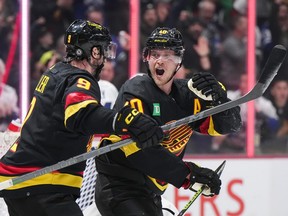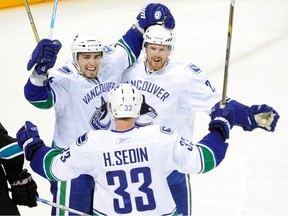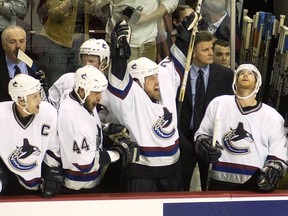The 2024 Vancouver Canucks have a lot going for them and there are some interesting comparisons to be made with the last two great squads.

Article content
With the Montreal Canadiens in town for a game at Rogers Arena on Thursday, let’s turn to two of their coaches, who both played on some pretty impressive Vancouver Canucks teams, for what they see in this Canucks team.
Advertisement 2
Article content
2011
Article content
Asked to make a comparison with the team he played on in 2011, Habs assistant coach Alex Burrows obviously agreed there are similarities. The Canucks are well-balanced at forward and Quinn Hughes is one of the best defencemen in the league, he said.
“And they got Roberto back there,” he quipped. “Thatcher. He’s been really good.
“They’re well coached. And should be interesting to see how they do down the stretch.”
Led by the Sedins, Burrows and Ryan Kesler, plus a strong defence corps and, of course, one of the best goalies in the league in Roberto Luongo, well you know how the story went.

Elias Pettersson and J.T. Miller drive the bus in similar fashion to the 2011 top-end, though neither Miller nor Pettersson is the two-way force that Kesler was that season. Brock Boeser has been finishing at a rate that compares well to Burrows.
Advertisement 3
Article content
On the blueline, 2011 didn’t have a defenceman quite at Hughes’ level, though they were at least as skilled across the board as this current group and probably a little deeper.
In net, only one team had a better team save percentage on the season than Vancouver: the Boston Bruins. Demko is one of the better goalies in the NHL right now, but he’s not quite at Luongo’s level.
The utility of shot-attempts percentage has changed since 2011. Teams understand which shots matter more than others so much better now, so understanding the data now requires a lot more nuance.
In 2011, the Canucks had the fifth-best shot-attempts percentage in the league. They controlled much of the play night-in, night-out. This season, they’re much more in the middle of the pack in shot-attempt percentage, but they’ve also led so much of the season it’s no surprise their shot share has been somewhat suppressed.
Article content
Advertisement 4
Article content
But the current squad also eschews long shots, while the 2010-11 team still liked to bomb away from the point.
The Sedin/Burrows line played the most of any trio that season and took 57 per cent of the shot attempts while they were on the ice together. The most effective Canucks line of any measure this season has been Miller with Boeser and Pius Suter, who have taken about 64 per cent of the shot attempts while on the ice.
Pettersson with Elias Lindholm and Nils Hoglander haven’t played a ton together, but they’ve taken more than 60 per cent of the shot attempts when they’ve been on the ice together.
In the success seen by both of those lines, there’s some comparison to be made with the Sedins’ success.
2003
Trevor Letowski was a depth winger on the Canucks for a season and a half from 2001 to 2003.
Advertisement 5
Article content
He was part of a team that was among the league’s best, at some points literally the best, in 2002-03, but which fell on its face in the playoffs, blowing a 3-1 lead in the second round to the Minnesota Wild.
Letowski is the Canadiens’ interim head coach, stepping in while head coach Martin St. Louis is away on personal leave.
“Oh that’s tough,” Letowski replied with a grin when asked about how the 2003 squad compares with Vancouver’s 2024 edition.
“Those two years that I spent here was exciting times. We had good teams that were probably good enough to win. We just didn’t … but that was an exciting time,” he said.
“Especially with Mo and with Nazy and with Bert,” he said, referring to Brendan Morrison, Markus Naslund and Todd Bertuzzi.
Advertisement 6
Article content

Those Canucks didn’t have a power house No. 1 defenceman like Hughes, but they were a solid group.
Shot data from before 2007 is pretty minimal, but we can still apply some lessons to the surface information we do have.
For instance, the 2003 Canucks allowed the sixth-fewest shots against and took the sixth-most shots for, a very good indicator of possession. Past analysis suggested that at even-strength, the Canucks had the 11th-best shot-attempts percentage in the league: so, good, but not great.
On offence, the 2003 squad featured two of the best players in the world in Naslund and Bertuzzi, plus the young Sedins and plenty of veteran savvy as well. That group was really pretty similar to what the current Canucks have. Miller and Pettersson are two of the best offensive players in the game, easy comparators to Naslund and Bertuzzi.
Advertisement 7
Article content
The 2003 squad didn’t have a Hughes type on the blueline, but there were some strong contributors like Ed Jovanovski and Mattias Ohlund.
Their overall shooting percentage of 11.2 per cent was more than two percentage points above league average, which is pretty similar to the Canucks in 2023-24, who have the best shooting percentage in the league at 12.3 per cent. Like in 2003 they’re also just over two per cent higher than the league average.
In goal, though, is the real difference and the biggest reason the 2003 Canucks came up short: Dan Cloutier.
He was colourful and battling, but he posted just a 90.8 save percentage that season, which wasn’t even league average and even more telling, was his career high.
Thatcher Demko he never was. Not even close.
Advertisement 8
Article content
Recommended from Editorial
Bookmark our website and support our journalism: Don’t miss the news you need to know — add VancouverSun.com and TheProvince.com to your bookmarks and sign up for our newsletters here.
You can also support our journalism by becoming a digital subscriber: For just $14 a month, you can get unlimited access to The Vancouver Sun, The Province, National Post and 13 other Canadian news sites. Support us by subscribing today: The Vancouver Sun | The Province.
Article content





